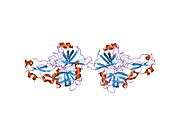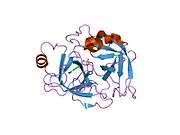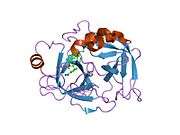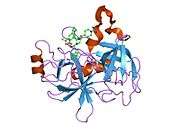ST14
Suppressor of tumorigenicity 14 protein, also known as matriptase, is a protein that in humans is encoded by the ST14 gene.[5] ST14 orthologs[6] have been identified in most mammals for which complete genome data are available.
Function
Matriptase is an epithelial-derived, integral membrane serine protease. This protease forms a complex with the Kunitz-type serine protease inhibitor, HAI-1, and is found to be activated by sphingosine-1-phosphate. This protease has been shown to cleave and activate hepatocyte growth factor/scatter factor, and urokinase plasminogen activator, which suggest the function of this protease as an epithelial membrane activator for other proteases and latent growth factors.[5]
Matriptase is a type II transmembrane serine protease expressed in most human epithelia, where it is coexpressed with its cognate transmembrane inhibitor, hepatocyte growth factor activator inhibitor (HAI)-1. Activation of the matriptase zymogen requires sequential N-terminal cleavage, activation site autocleavage, and transient association with HAI-1. Matriptase has an essential physiological role in profilaggrin processing, corneocyte maturation, and lipid matrix formation associated with terminal differentiation of the oral epithelium and the epidermis, and is also critical for hair follicle growth. Matriptase is an 80- to 90-kDa cell surface glycoprotein with a complex modular structure that is common to all matriptases.
Clinical significance
The expression of this protease has been associated with breast, colon, prostate, and ovarian tumors, which implicates its role in cancer invasion, and metastasis.[5]
Matriptase and HAI expression are frequently dysregulated in human cancer, and matriptase expression that is unopposed by HAI-1 potently promotes carcinogenesis and metastatic dissemination in animal models.
References
- 1 2 3 GRCh38: Ensembl release 89: ENSG00000149418 - Ensembl, May 2017
- 1 2 3 GRCm38: Ensembl release 89: ENSMUSG00000031995 - Ensembl, May 2017
- ↑ "Human PubMed Reference:".
- ↑ "Mouse PubMed Reference:".
- 1 2 3 "Entrez Gene: ST14 suppression of tumorigenicity 14 (colon carcinoma)".
- ↑ "OrthoMaM phylogenetic marker: ST14 coding sequence".
Further reading
- Uhland K (2007). "Matriptase and its putative role in cancer". Cell. Mol. Life Sci. 63 (24): 2968–78. doi:10.1007/s00018-006-6298-x. PMID 17131055.
- Zhang Y, Cai X, Schlegelberger B, Zheng S (1999). "Assignment1 of human putative tumor suppressor genes ST13 (alias SNC6) and ST14 (alias SNC19) to human chromosome bands 22q13 and 11q24→q25 by in situ hybridization". Cytogenet. Cell Genet. 83 (1–2): 56–7. doi:10.1159/000015125. PMID 9925927.
- Lin CY, Anders J, Johnson M, et al. (1999). "Molecular cloning of cDNA for matriptase, a matrix-degrading serine protease with trypsin-like activity". J. Biol. Chem. 274 (26): 18231–6. doi:10.1074/jbc.274.26.18231. PMID 10373424.
- Lin CY, Anders J, Johnson M, Dickson RB (1999). "Purification and characterization of a complex containing matriptase and a Kunitz-type serine protease inhibitor from human milk". J. Biol. Chem. 274 (26): 18237–42. doi:10.1074/jbc.274.26.18237. PMID 10373425.
- Takeuchi T, Shuman MA, Craik CS (1999). "Reverse biochemistry: use of macromolecular protease inhibitors to dissect complex biological processes and identify a membrane-type serine protease in epithelial cancer and normal tissue". Proc. Natl. Acad. Sci. U.S.A. 96 (20): 11054–61. doi:10.1073/pnas.96.20.11054. PMC 34240. PMID 10500122.
- Takeuchi T, Harris JL, Huang W, et al. (2000). "Cellular localization of membrane-type serine protease 1 and identification of protease-activated receptor-2 and single-chain urokinase-type plasminogen activator as substrates". J. Biol. Chem. 275 (34): 26333–42. doi:10.1074/jbc.M002941200. PMID 10831593.
- Lee SL, Dickson RB, Lin CY (2001). "Activation of hepatocyte growth factor and urokinase/plasminogen activator by matriptase, an epithelial membrane serine protease". J. Biol. Chem. 275 (47): 36720–5. doi:10.1074/jbc.M007802200. PMID 10962009.
- Tanimoto H, Underwood LJ, Wang Y, et al. (2001). "Ovarian tumor cells express a transmembrane serine protease: a potential candidate for early diagnosis and therapeutic intervention". Tumour Biol. 22 (2): 104–14. doi:10.1159/000050604. PMID 11125283.
- Oberst M, Anders J, Xie B, et al. (2001). "Matriptase and HAI-1 are expressed by normal and malignant epithelial cells in vitro and in vivo". Am. J. Pathol. 158 (4): 1301–11. doi:10.1016/S0002-9440(10)64081-3. PMC 1891898. PMID 11290548.
- Benaud C, Oberst M, Hobson JP, et al. (2002). "Sphingosine 1-phosphate, present in serum-derived lipoproteins, activates matriptase". J. Biol. Chem. 277 (12): 10539–46. doi:10.1074/jbc.M109064200. PMID 11792696.
- Ihara S, Miyoshi E, Ko JH, et al. (2002). "Prometastatic effect of N-acetylglucosaminyltransferase V is due to modification and stabilization of active matriptase by adding beta 1-6 GlcNAc branching". J. Biol. Chem. 277 (19): 16960–7. doi:10.1074/jbc.M200673200. PMID 11864986.
- Peek M, Moran P, Mendoza N, et al. (2003). "Unusual proteolytic activation of pro-hepatocyte growth factor by plasma kallikrein and coagulation factor XIa". J. Biol. Chem. 277 (49): 47804–9. doi:10.1074/jbc.M209778200. PMID 12372819.
- Strausberg RL, Feingold EA, Grouse LH, et al. (2003). "Generation and initial analysis of more than 15,000 full-length human and mouse cDNA sequences". Proc. Natl. Acad. Sci. U.S.A. 99 (26): 16899–903. doi:10.1073/pnas.242603899. PMC 139241. PMID 12477932.
- Benaud CM, Oberst M, Dickson RB, Lin CY (2003). "Deregulated activation of matriptase in breast cancer cells". Clin. Exp. Metastasis. 19 (7): 639–49. doi:10.1023/A:1020985632550. PMID 12498394.
- Oberst MD, Williams CA, Dickson RB, et al. (2003). "The activation of matriptase requires its noncatalytic domains, serine protease domain, and its cognate inhibitor". J. Biol. Chem. 278 (29): 26773–9. doi:10.1074/jbc.M304282200. PMID 12738778.
- Santin AD, Cane' S, Bellone S, et al. (2003). "The novel serine protease tumor-associated differentially expressed gene-15 (matriptase/MT-SP1) is highly overexpressed in cervical carcinoma". Cancer. 98 (9): 1898–904. doi:10.1002/cncr.11753. PMID 14584072.
- Suzuki M, Kobayashi H, Kanayama N, et al. (2004). "Inhibition of tumor invasion by genomic down-regulation of matriptase through suppression of activation of receptor-bound pro-urokinase". J. Biol. Chem. 279 (15): 14899–908. doi:10.1074/jbc.M313130200. PMID 14747469.
- Hung RJ, Hsu IaW, Dreiling JL, et al. (2004). "Assembly of adherens junctions is required for sphingosine 1-phosphate-induced matriptase accumulation and activation at mammary epithelial cell-cell contacts". Am. J. Physiol., Cell Physiol. 286 (5): C1159–69. doi:10.1152/ajpcell.00400.2003. PMID 15075215.
- Sun LF, Zheng S, Shi Y, et al. (2004). "[SNC19/ST14 gene transfection and expression influence the biological behavior of colorectal cancer cells]". Zhonghua Yi Xue Za Zhi. 84 (10): 843–8. PMID 15200890.
- Gerhard DS, Wagner L, Feingold EA, et al. (2004). "The status, quality, and expansion of the NIH full-length cDNA project: the Mammalian Gene Collection (MGC)". Genome Res. 14 (10B): 2121–7. doi:10.1101/gr.2596504. PMC 528928. PMID 15489334.







